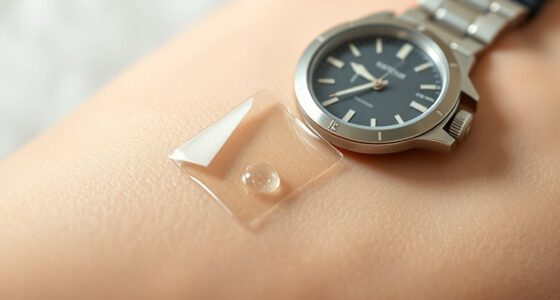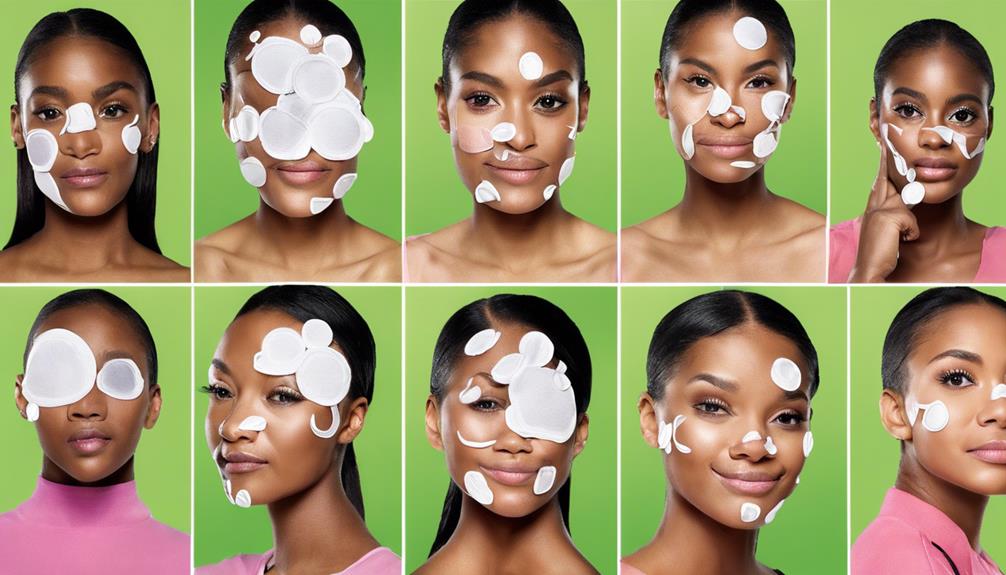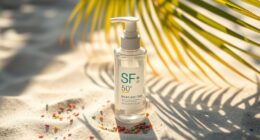To level up your skincare routine with pimple patches, layer them after cleansing and toning for the best adhesion. Make sure to apply them on blemishes and leave them on for 6-8 hours to reap maximum benefits. Remember, always layer products from thinnest to thickest, allowing a minute between each for better absorption. Avoid mixing too many ingredients that can irritate your skin. There’s still more to discover about optimizing your routine for healthier skin!
Key Takeaways
- Apply pimple patches after cleansing and toning for optimal adhesion and effectiveness.
- Allow 30 seconds to 1 minute between layers to ensure full absorption of active ingredients.
- Use patches as a targeted treatment, applying them directly to blemishes for maximum impact.
- Avoid layering too many products on areas with patches to prevent irritation and enhance results.
- Monitor your skin’s response to patches and adjust your overall routine accordingly for best outcomes.
Understanding the Importance of Layering in Skincare

When you layer your skincare products correctly, you not only boost their effectiveness but also assure your skin gets the greatest benefits.
Start with thinnest to thickest to facilitate ideal absorption of active ingredients. Applying serums and treatments first allows these powerful components to penetrate clean skin better.
Begin with the thinnest products first to enhance absorption and allow potent ingredients to effectively penetrate your skin.
Then, seal in hydration with thicker creams and oils. Remember to give each layer about 30 seconds to 1 minute to absorb fully; this minimizes irritation and maximizes results.
Avoid overloading your skin with too many products, as this can compromise your skin barrier. Tailoring your routine to your specific skin type enhances product performance and contributes to healthier skin over time.
Prioritize consistency for the best outcomes!
Choosing the Right Products for Your Skin Type

Choosing the right products for your skin type can dramatically enhance the benefits of your carefully layered routine. Start by identifying your skin type—oily, dry, combination, or sensitive—to choose products that effectively address your specific needs. Here’s a quick guide:
| Skin Type | Recommended Ingredients |
|---|---|
| Oily/Acne-Prone | Non-comedogenic moisturizers, salicylic acid |
| Dry | Hyaluronic acid, glycerin |
| Sensitive | Fragrance-free, hypoallergenic products |
For oily or acne-prone skin, look for non-comedogenic options to avoid breakouts. If your skin’s dry, prioritize humectants to boost hydration. Sensitive skin requires gentle, irritation-free ingredients. Additionally, incorporating products with glycolic acid can help improve skin texture and tone. Adjust your routine with the seasons to optimize effectiveness!
The Role of Patches in Your Skincare Routine

Patches play an essential role in your skincare routine, especially when it comes to targeting pesky blemishes. Pimple patches provide a focused treatment that helps reduce inflammation and speeds up healing.
They often contain active ingredients like salicylic acid, hydrocolloid, or tea tree oil, which absorb excess oil and impurities, aiding in faster blemish recovery. For the best results, apply the patches after cleansing and toning, ensuring they stick to clean skin without interference from other products.
Ideally, leave them on for 6-8 hours, making them perfect for overnight use. By incorporating patches into your routine, you create a protective barrier that enhances the effectiveness of other treatments, like serums or spot treatments, bringing you closer to clearer skin. Additionally, using effective pimple patches can significantly improve your chances of achieving a blemish-free complexion.
How to Incorporate Pimple Patches Effectively

Incorporating pimple patches into your skincare routine can considerably enhance your blemish-fighting efforts. Start by ensuring your skin is clean and dry.
After applying moisturizer, place pimple patches directly over active breakouts. This helps absorb excess fluid and reduces inflammation effectively. Make sure not to layer any other products beneath the patches; this allows the hydrocolloid material to work its magic without interference.
For ideal results, wear the pimple patches overnight or for several hours during the day, giving them uninterrupted time to work. By making pimple patches the final step in your routine, you’ll maximize their effectiveness while locking in hydration, helping you tackle those pesky blemishes effectively.
Layering Order: Thinnest to Thickest

To achieve the best results from your skincare routine, it’s essential to layer products from thinnest to thickest.
Start with toners and essences, as they penetrate the skin effectively. Next, incorporate hydrating serums containing hyaluronic acid to attract moisture.
Begin your routine with toners and essences for optimal absorption, then follow with hydrating serums rich in hyaluronic acid to lock in moisture.
After that, apply your moisturizer to seal in hydration, followed by oils if desired. This order maximizes absorption, preventing heavier products from blocking lighter ones.
When you’re ready to apply patches, do so after your serum or moisturizer for ideal adhesion and delivery of active ingredients.
Remember to give each layer time to absorb for about 30 seconds to 1 minute. This layering order helps you achieve radiant, well-hydrated skin.
Timing Matters: Allowing Absorption Between Layers

While it might be tempting to layer your skincare products quickly for convenience, taking the time to allow each layer to absorb can greatly enhance your routine’s effectiveness. Aim for a 30 seconds to 1 minute wait between applications. This not only guarantees ideal absorption of active ingredients but also prevents irritation from product overload. Start with thinner products like serums, then move to thicker creams. Consistent timing improves each product’s performance and promotes a healthier skin barrier.
| Layer Type | Application Time | Benefits |
|---|---|---|
| Serums | 30 seconds | Enhanced absorption |
| Essences | 30 seconds | Active ingredient penetration |
| Creams | 1 minute | Hydration and barrier support |
| Treatments | 1 minute | Targeted care |
| Sunscreen | 1 minute | Protection against UV damage |
Common Mistakes to Avoid When Layering

When it comes to layering your skincare, it’s easy to make mistakes that can hinder your results.
Overloading your routine with too many products or applying them in the wrong order can lead to irritation and reduced effectiveness.
Let’s explore some common pitfalls to avoid for a smoother, more effective layering process.
Overloading With Products
Overloading your skincare routine with too many products at once can lead to irritation and compromise your skin barrier. You might think layering is the key to radiant skin, but it can backfire. Using multiple active ingredients, like retinol and AHAs/BHAs, can irritate the skin and increase dryness.
Ensure you’re mindful of product compatibility, as mixing niacinamide with vitamin C can negate their benefits. Here’s a quick reference to common layering pitfalls:
| Mistake | Consequence |
|---|---|
| Overloading with too many products | Irritation, breakouts |
| Applying products in the wrong order | Hindered absorption, less effectiveness |
| Ignoring ingredient compatibility | Ineffective routine |
Limit your actives, and always allow time between layers for best results! Additionally, using hydrocolloid patches can provide focused treatment without overwhelming your skin with too many products.
Incorrect Application Order
Using the wrong application order can sabotage even the best skincare products. When layering, always apply lighter serums before thicker creams or oils. This guarantees active ingredients penetrate your skin effectively.
Avoid using products with conflicting pH levels, like retinol and vitamin C, together; apply them at different times to preserve their benefits. Layering multiple exfoliating products, such as AHAs and BHAs, can lead to over-exfoliation, causing irritation.
Always wait 30 seconds to 1 minute between layers to prevent product mixing, which can diminish effectiveness. Finally, apply spot treatments on clean, targeted areas first; neglecting this step can dilute their impact and prolong breakouts.
Combining Active Ingredients: What Works and What Doesn’t

While maneuvering the world of skincare, understanding which active ingredients can be combined effectively is essential for achieving the best results. Here’s a quick guide for combining active ingredients in your skincare products:
Navigating skincare requires knowing which active ingredients work well together for optimal results.
- Retinol & Niacinamide: Layering niacinamide can help reduce irritation from retinol, making it suitable for sensitive skin.
- AHAs/BHAs & Retinol: Avoid mixing these as they can increase irritation and dryness, compromising your skin barrier.
- Vitamin C & Retinol: Apply them separately; using them together can lower their effectiveness due to differing pH levels.
- Niacinamide & Hyaluronic Acid: This combination hydrates while improving texture and reducing the appearance of pores.
Additionally, incorporating regular skin treatments can enhance the overall effectiveness of your layered skincare routine by targeting specific concerns and boosting skin health.
Adapting Your Routine for Seasonal Changes

As seasons shift, it’s essential to adapt your skincare routine to meet your skin’s changing needs. Different climates affect hydration and oil production, so choose your products wisely. In winter, use richer moisturizers to fight dryness, while summer calls for lightweight, non-comedogenic options. Shifting seasons? Add a hydrating serum with hyaluronic acid to keep moisture levels balanced.
| Season | Recommended Products | Key Focus |
|---|---|---|
| Winter | Rich moisturizers | Combat dryness |
| Summer | Lightweight, non-comedogenic formulas | Prevent clogged pores |
| Shifting | Hydrating serums | Maintain moisture balance |
Don’t forget to monitor your skin’s response to sun exposure and adjust your routine accordingly for seasonal changes.
Tips for Maintaining a Healthy Skin Barrier

To keep your skin barrier healthy, avoid over-exfoliating, as it can lead to irritation and imbalance. Instead, focus on hydration by incorporating a rich moisturizer that locks in moisture and supports your skin’s natural defenses. Regular maintenance, similar to the filter replacement recommended for air purifiers, is essential for maintaining optimal skin health.
Avoid Over-Exfoliation Practices
Exfoliating your skin is essential for a fresh, glowing complexion, but overdoing it can wreak havoc on your skin barrier.
Here are some tips to avoid over-exfoliation:
- Limit chemical exfoliation with AHAs and BHAs to just 3-4 times a week.
- Alternate exfoliation days with hydration-focused products like hyaluronic acid to keep moisture levels balanced.
- Always follow up exfoliation with a soothing moisturizer to replenish your skin barrier and prevent dryness.
- Conduct patch tests when introducing new exfoliating products to avoid irritation and verify they work well for your skin type.
Hydration and Moisture Balance
Maintaining a healthy skin barrier is essential for keeping your complexion hydrated and protected from environmental stressors. To achieve ideal hydration and moisture balance, consider using effective skincare products with key ingredients like hyaluronic acid. Here’s a quick guide:
| Step | Product Type | Purpose |
|---|---|---|
| 1 | Toner | Prepares skin for absorption |
| 2 | Hydrating Serum | Attracts moisture |
| 3 | Lightweight Moisturizer | Seals in hydration |
| 4 | Sunscreen | Protects against UV damage |
| 5 | Non-comedogenic Products | Prevents clogged pores |
Incorporating dynamic contrasts in your skincare routine can also enhance product effectiveness and overall skin health.
Frequently Asked Questions
Should You Put a Spot Patch on Before or After Skincare?
You should put a spot patch on after your skincare routine. By applying it last, you let your serums and moisturizers penetrate your skin without interference.
Make sure your skin is clean and dry first. If you’ve used a spot treatment before the patch, let it dry completely.
For the best results, keep the patch on for the recommended time to effectively draw out impurities and deliver active ingredients to the blemish.
What Is the 3 Second Rule in Skincare?
Did you know that applying your skincare products within three seconds of cleansing can increase absorption by up to 80%?
The 3 Second Rule is all about quick application after you wash your face. It helps your skin stay hydrated and balanced, maximizing the effectiveness of your products.
To make this work, have your skincare items ready at hand so you can layer them quickly and efficiently without letting your skin dry out.
Do You Put Mighty Patch on Before or After Moisturizer?
You should apply Mighty Patch after your moisturizer for the best results.
This guarantees the patch adheres properly to your skin and effectively targets blemishes without interference from other products.
If you prefer, you can also use it on bare skin for maximum contact.
Just remember to keep your skin completely dry before application, and leave the patch on for at least 6 hours or overnight to let it work its magic on your pimple.
What Is the 7 Layer Skincare Method?
The 7 Layer Skincare Method involves applying seven different products in a specific order, starting with the thinnest and moving to the thickest.
You’ll use lightweight, hydrating formulas like essences and serums, allowing your skin to absorb each layer effectively.
It’s essential to wait about 30 seconds to a minute between applications to maximize hydration.
This method’s great for enhancing skin texture and locking in moisture, especially if you have dry or dehydrated skin.
Conclusion
By mastering the art of layering, you can transform your skincare routine into a powerhouse of hydration and healing. Remember to choose products suited to your skin type and follow the layering order for maximum effectiveness. Avoid common mistakes and stay mindful of ingredient combinations to keep your skin thriving. With these tips, you’ll have skin so radiant it could outshine the sun itself. Embrace these hacks, and watch your complexion flourish like never before!
Claire has a knack for turning complex dermatological concepts into engaging, easy-to-understand articles. Her work primarily focuses on creating detailed reviews and thought-provoking articles in the “Vetted” category. Claire’s writing not only informs but also inspires our community to try new skincare solutions.










